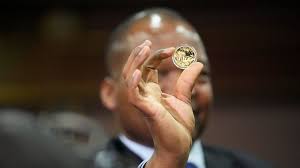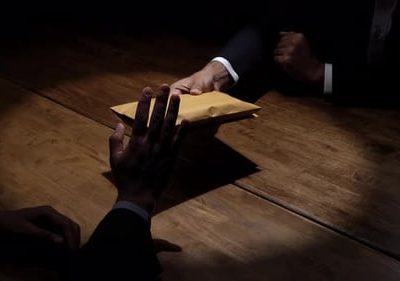Gold coins introduced by Reserve Bank of Zimbabwe RBZ Governor Dr John Panonetsa Mangudya have rescued Zimbabwe whose introduction mopped up excess liquidity in the market and halted runaway inflation bearing fruit, at least for now.
The Rbz Coins have been credited for halting the decline in the parallel market rate for the Zimbabwe dollar, allowing it to converge with the official rate, which has plunged more than 80% against the US currency this year. Since 12 October 2022, both the official and the black market rates traded at Z$650 to the greenback.
Officially called “Mosi-oa-Tunya” named after the seventh wonder of the world, the Victoria Falls, the Gold Coins were among a coterie of interventions introduced by the Rbz Governor Dr Mangudya to stabilise the Zimbabwe economy, including a sharp increase in the bank policy rate from 80% to 200%. The bank policy rate is used by banks to benchmark minimum lending rates.
Governor, Dr Mangudya said in mid-September that the Bank’s Monetary Policy Committee “noted with satisfaction the improved market confidence and uptake of gold coins as an alternative investment instrument to the US dollar”.
The Rbz Governor has been supplying the market with one-ounce coins, which hit the market at US$1,884.80 or Z$936,589.89, which saw fewer ordinary people participating because of the elevated price.
Governor Mangudya will in two weeks time introduce lower denomination gold coins to enable the participation of ordinary citizens. The smallest, a tenth of an ounce, will be made available to the public through banks and approved dealers.
New lesser valued gold coins, will contain just over 3.11 grams of gold, and will cost US$188.48 or the local currency equivalent at the interbank rate, at one-tenth of the price of the first gold coin released in July.
A more optimistic analyst said gold coins were a viable alternative to restore the value of local currency in the face of increased instability.
“The timing of the issuance of these smaller denominations is important as it coincides with increased local currency liquidity from bonus payments. This will address the concern that the product was designed for the elite,” the optimistic analyst said.
This has seen the Official rate gain favour with the convergence of the exchange rates welcomed by Zimbabwean retailers, who are now trying to woo shoppers to spend their US dollars in-store by offering better exchange rates than the black market.
This’s the first time in three years that momentum has swung in favour of the official markets and may help bring the southern African nation’s runaway inflation under control.
Zimbabwe’s interbank rate at which most commerce takes place set trading at Z$650 against the US currency. Allowing for the 10% mark-up businesses can charge, that puts the exchange rate of Z$715 above the parallel market rate of Z$630-Z$650 per dollar.
“More and more US dollar transactions are moving to the formal market,” according to an economist based in the capital Harare. The demand for US dollars from the RBZ by companies is also showing signs of easing. RBZ Governor Dr Mangudya allocated US$11m to businesses at its auction on 27 September – a two-year low – from highs of US$50m.
This converged rate will now allow formal retailers to correct the ‘pricing distortions’ caused when they were forced to peg to an overvalued interbank rate, according to, head of research at Harare-based brokerage firm IH Securities.
President Emmerson Mnangagwa claimed that Zimbabweans had an appetite for gold coins, hence government will introduce smaller coins next month.
“The Reserve Bank of Zimbabwe has sold over 10,000 gold coins for about US$15m. This means Zimbabweans have an appetite for gold coins and to save. Our target is to release US$30m worth of coins.
“By mid-November this year, the RBZ should be in a position to unveil smaller denominations of gold coins, whose value will range from a tenth, a quarter, to half of an ounce,” Mnangagwa said in his weekly column in the state media.
These coins complement similar measures by the Treasury, which in July demanded a review of all government supply contracts priced using parallel market exchange rates, which contributed to the creation of excess liquidity that ended up driving exchange rate volatility on the black market. Inflation and the exchange rate have largely been stable since the government escalated interventions to squeeze excess liquidity from the market, with the local currency appreciating against the US dollar on the black market while inflation has started falling.
World international lenders believe it is however an Opportunity lost after the International Monetary Fund (IMF) said the Zimbabwean gold coins are a missed chance to build the nation’s gold reserves. An IMF spokesperson said: “The sale of gold coins has contributed to withdrawing Zimbabwe dollar liquidity from the market, though it represents an opportunity cost in terms of foregone reserves for the Reserve Bank of Zimbabwe.”
Zimbabwe’s Gold output surged 41% in the first eight months of the year to 22,290kg from a year earlier. The country aims to produce 35 tons of bullion in 2022.
Since 22 September 2022, a total of 9,516 gold coins valued at Z$9bn (US$1=Z$650) had been sold to both individuals and corporate buyers, according to the Reserve Bank of Zimbabwe Governor, Dr John Mangudya. Each coin weighs one troy ounce and has a purity of 22 carats.
Single Individual buyers had taken up 35% of the bullion, with 65% being snapped up by corporates.These gold coins are minted by the RBZ-owned Fidelity Printers, the sole buyer of gold in the country.Their price is determined by the international market rate for an ounce of gold, plus five per cent for the cost of producing the coin.
The Rbz Governor took the unprecedented step of introducing gold coins as legal tender after inflation spiked from 191% in June to 257% in July this year. The local currency tumbled in worth from Z$108.66 to US$1 at the start of the year, to Z$481.85 to US$1 in August at the official rate, and to Z$800 to US$1 on the black market.
Mosi – oa – Tunya gold coins were introduced on 25 July as part of several policy measures to ease demand for the greenback, stabilise the Zimbabwe dollar exchange rate and tame resurgent inflation.The Sky-rocketing inflation saw people rushing to cash in their Zimbabwean dollars for US dollars, to stop their savings losing value.
This saw a shortage of US currency and drove up exchange rates, so the Rbz Governor Dr Mangudya reacted by halting loans.
Economic Commentators are however not agreed on whether Rbz’s measures will bring about the desired results. Critic and Former Finance Minister and Citizens Coalition for Change CCC Vice President Tendai Biti said the gold coins “are just another form of arbitrage and looting from the public to enrich cartels”.
Biti said that the central bank bought gold coins for about US$18m and sold them for about US$10m, using a discount rate of about 300% which is below the market rate, creating an arbitrage.
These serious Arbitrage allegations is the simultaneous purchase and sale of an asset in different markets to exploit tiny differences in their prices.
Another Economic Analyst said that while gold coins might temporarily slow down inflation and reduce pressure on the exchange rate, they would not address the economic crisis in the country.
“The introduction of smaller denominations of gold coins is not going to address the economic crisis in the country. There is the need for more holistic and comprehensive measures to turn around the ailing economy,” the Analyst said.







Comments